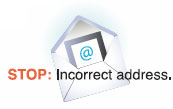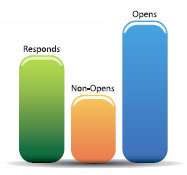The full range of your grocery business' services may not be immediately obvious to your potential customers. They may know of the location of your outlet by passing by your signs, but they may not know that you are offering the exact truffle oil, Spanish saffron or bulk pasta they need. In order for your grocery email campaign to appeal to the right prospects, the following factors must be taken into consideration.

Implementation
Traditional forms of advertising - such as newspapers, magazines, radio, television and Yellow Page listings - are subject to a different set of legal criteria than email marketing. These differences are particularly evident in the cases of
opt-in subscription lists.
Compliance
Though it may not be unusual for your grocery business to gather customer information through signup sheets and business card drop boxes, federal law requires customer information be entered on to your list only after your business receives explicit and documented permission from the prospect. Violating these regulations is a crime, with penalties including heavy fines and potential incarceration.
Federal CAN-SPAM Law Regulates Email Marketing
The US
CAN-SPAM Act regulates the way commercial marketers are beholden to subscribers. CAN-SPAM is an opt out form of legislation, demanding that any business that sends emails to subscribers must immediately remove an email address from their list at the subscriber's first request. Failure to honor the subscriber's initial request opens up the grocery business owner or manager to extensive legal penalties, including fines and imprisonment.
Facilitate Unsubscribing

When a customer wishes to no longer receive your newsletters, federal law requires that your promotions must contain an accessible and easily visible unsubscription link in all outgoing
email marketing campaign sends. Once the unsubscribe request has been performed, your company must act immediately to delete all the customer's personal data from your computer systems and ensure that no further commercial emails are sent to that email address under penalty of law.
Control Bouncing Emails
Any email sent out by your grocery business, regardless of whether it is a personal message, a commercial reply or a campaign newsletter, results in one of these three end points:
Successful: The email is delivered properly.
Soft Bounce: The email is delayed, possibly indefinitely, because your customer's inbox is too full, or there are network problems.
Hard Bounce: The email cannot be delivered because the email address cannot be found or has been blocked.

In case number two and three, an Internet function called a Mailer Daemon will send you an email notification indicating your send was not delivered and an explanation why. Although soft bounces are not the sender's fault, it is considered good email practice to attempt to contact the customer through other available means to inform them your emails are being returned. A hard bounce is a more serious problem, as the fault lies with the sender. When emails are repeatedly sent to addresses that are non-existent or blocked, the sender will be identified by ISPs as a spammer and placed on a blacklist. At that point, the sender will no longer be able to transmit email marketing newsletters or personal or business emails.
Privacy Policy
Though it may be tempting to visit a competitor's website and duplicate their privacy policy, not developing your own business-specific policy opens up your organization to potential legal liability. A business attorney should always draft a custom-tailored privacy policy for your specific online business.
Segment Your Subscription List

Some grocery store marketing departments create a single periodical email newsletter to send to their entire subscriber base without utilizing segmentation opportunities. By segmenting your list, you can provide a different message for each demographic, income and behavior group – meeting the client where they are. Your territory might encompass very disparate earnings groups, and you should tailor your content to each one. Segmentation allows you to separate these groups and create specific newsletter content appealing to individual wants and needs.
Test Your Email Content
Few grocery business owners or managers report to be currently testing their email content. The A/B split test is one of the most effective and well-known tests available, allowing you to determine how subscribers respond to varying elements within an email. The effects of changing a single aspect of the email, such as the main link or image positioning, can be analyzed by reviewing the open and click-through rates. By repeated A/B split testing, you will be able to identify the email elements most effective for maximizing your email marketing strategy.
Solicit Your Customer's Personal Data
Demographic information is of critical importance to the proper segmentation of your subscription list. However, many of your grocery business' shoppers will be recalcitrant to provide that data.
Online surveys are a successful way for grocery stores to obtain this information, as are physical signup sheets near the cash registers or posted to a community bulletin board.
Analyze Your Customer's Behaviors

Email marketing metrics such as open and click-through rates are primary indicators of a customer's general behavior patterns when they receive your grocery business' emails. Some customers don't open your emails at all, and should be deleted from your subscription list. Other subscribers open and read your emails but rarely follow through with online clicks. These customers should be kept on your subscription list, since they are at least being reached by your emails, and may be the types of shoppers likely to be aware of your ongoing grocery promotions and sales through other mediums. The third group is the customer who both habitually reads and clicks through to your
landing pages. These are the most desirable prospects. Their response to your campaign is easily quantifiable, thus they provide valuable data to assist in your segmentation procedures.
Good Email Practice
Industry standard email practices should be integrated into all of your email marketing campaigns. Subject lines and preheaders should be finely crafted to ensure customers have an incentive to actually open the email and read it. Your email template should have cross-browser display, and your strategy should include multiple landing pages designed to dovetail with your segmentation and subsequent A/B split testing efforts.
Email Metrics
The statistics in this guide demonstrate that over 40 percent of grocery business owners and managers are not currently aware of their campaign's click-through rate; nearly 25 percent are also unaware of their open rates. By not grasping these basic
email marketing metrics, grocery business managers or owners cannot accurately analyze the particular factors that indicate the performance of their overall online marketing and promotional campaigns.